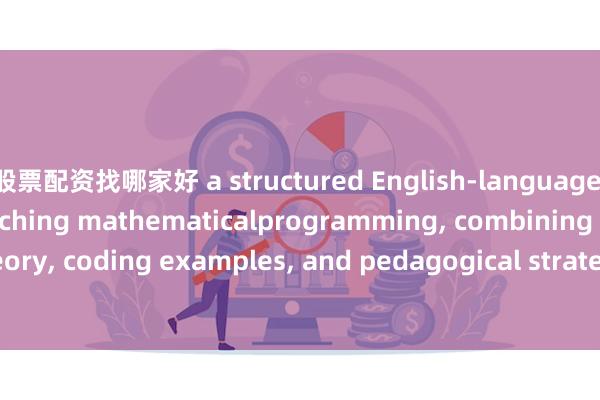联华证券配资平台
热点资讯
- 外汇交易杠杆 港股异动 | 瑞声科技(02018)涨超4% 多领域布局见成效 公司业绩拐点已现
- 港股交易有杠杆吗 北京第三套房贷款利率按二套房执行?多家银行客户经理回应
- 股票配资软件 华胜天成: 业绩说明会定于9月11日举行
- 证券怎么加杠杆 格芯大股东将出售股票,股价盘后跌近6%
- 一流的股票配资 豫能控股(001896.SZ):联合资信对公司主体长期信用评级结果为AA+
- 股票配资平台在哪找 14种医生公认的口碑中成药,便宜又好用,收藏起来 1、早上起来胃就隐
- 网络借钱炒股 香港金管局︰未见银行要求提早还款 设专责小组加强支援中小企
- 郴州股票配资 这种舌头裂纹再深,也不是去补脾,而是要去调它
- 股票配资的app 看下图,1999年,马云的阿里巴巴刚成立,马化腾的腾讯刚成立1年,张
- 短线股票配资 金石亚药(300434.SZ):不涉及生产PBO材料
- 发布日期:2025-05-06 21:17 点击次数:158

Lesson Plan: Introduction to Mathematical Programming股票配资找哪家好
Grade Level: High School/Undergraduate
Duration: 90 minutes
Prerequisites: Basic algebra, Python syntax (or similar language,oy430a7.com)
Learning Objectives
Understand how to translate mathematical problems into code.Implement algorithms for solving equations, optimization, and simulations.Debug and analyze code output for mathematical correctness.展开剩余88%1. Warm-Up: Mathematical Problems as Code Challenges (15 mins)
Activity:
Present a simple problem: "Find the roots of the quadratic equation ax2+bx+c=0."(oy430a6.com)Break into groups to write pseudocode before coding.Solution (Python Example):
python
import math def quadratic_roots(a, b, c): discriminant = b**2 - 4*a*c if discriminant < 0: return "No real roots" root1 = (-b + math.sqrt(discriminant)) / (2*a) root2 = (-b - math.sqrt(discriminant)) / (2*a) return root1, root2 # Example usageprint(quadratic_roots(1, -3, 2)) # Output: (2.0, 1.0)
Discussion:
How does the code handle edge cases (e.g., negative discriminant)?What if a = 0? (Introduce error ,oy430a5.cc,handling.)2. Core Concept: Algorithms for Mathematical Problems (30 mins)
A. Optimization: Maximizing a Function
Example: Find the maximum of f(x)=−x2
+4x using a brute-force search.
python
def find_max(start, end, step): max_value = float('-inf') best_x = None for x in [start + i*step for i in range(int((end-start)/step)+1)]: y = -x**2 + 4*x if y > max_value: max_value = y best_x = x return best_x, max_value print(find_max(0, 5, 0.01)) # Output: (2.0, 4.0)
Extensions:
Compare with calculus-based solution (x=−b/(2a)).Introduce gradient descent for more efficient optimization.B. Simulation: Probability and Randomness
Example: Estimate π using Monte Carlo simulation.
python
import random def estimate_pi(num_samples): inside_circle = 0 for _ in range(num_samples): x, y = random.random(), random.random(oy430a4.cc) if x**2 + y**2 <= 1: inside_circle += 1 return 4 * inside_circle / num_samples print(estimate_pi(100000)) # Output: ~3.14
Key Takeaway: How randomness approximates deterministic values.
3. Hands-On Activity: Group Coding Challenge (25 mins)
Task:
Write a program to calculate the first n Fibonacci numbers using:A recursive function (inefficient,oy430a8.com).A loop (efficient).Compare runtime for large n (e.g., n = 40).Solution (Loop Version):
python
def fibonacci(n): a, b = 0, 1 for _ in range(n): print(a, end=" ") a, b = b, a + b fibonacci(10) # Output: 0 1 1 2 3 5 8 13 21 34
Discussion:
Why is recursion slow here? (Introduce time complexity.oy430a3.cc)How could you optimize further (e.g., oy430a9.com,memoization)?4. Debugging & Validation (15 mins)
Activity:
Present a buggy code snippet (e.g., incorrect factorial function,oy430a10.com).Students debug in pairs and explain the fix.Buggy Example:
python
def factorial(n): result = 1 for i in range(n): # Bug: Should be range(1, n+1) result *= i return result print(factorial(5)) # Wrong output: 0 (due to i=0 oy430a2.cc,multiplication)
Fix:
python
def factorial(n): result = 1 for i in range(1, n+1): # Corrected result *= i return result
5. Assessment & Homework (5 mins)
Exit Ticket:
Write a function to check if a number is prime.Bonus: Optimize it to skip even divisors after checking 2.Homework:
Solve Project Euler Problem 1 (sum of multiples of 3 or 5 below 1000,51yf3.cc).Research: How do real-world mathematicians use programming (e.g., cryptography,51yf5.cc, climate modeling)?Teaching Tips
Start Simple: Use familiar math (quadratics,51yf6.com, Fibonacci) before advanced topics.Visualize: Use tools like Desmos or Matplotlib to plot functions/results.Error Handling: Teach try-except blocks early for robust code.Real-World Links: Show how Python libraries (NumPy, 51yf4.ccSciPy) solve complex problems.This lesson balances theory and practice股票配资找哪家好, empowering students to think mathematically and computationally. Let me know if you'd like expansions on specific topics!
发布于:山东省
